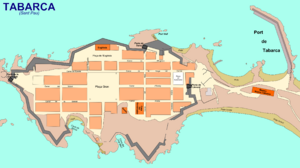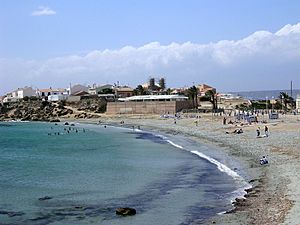Tabarca facts for kids
 |
|
| Geography | |
|---|---|
| Coordinates | 38°09′59″N 0°28′56″W / 38.16639°N 0.48222°W |
| Administration | |
| Region | Valencian Community |
| Province | Province of Alicante |
| Municipality | Alicante |
| Demographics | |
| Population | 68 (2011) |
Tabarca is a small island, also called an islet, located in the Mediterranean Sea. You can find it near the town of Santa Pola in the province of Alicante, Valencian Community, Spain. Its official name is Nueva Tabarca. People also know it as Isla Plana in Spanish and Nova Tabarca or Illa Plana in Valencian.
Tabarca is special because it is the largest island in the Valencian Community. It is also the smallest island in Spain where people live all year round. The island is famous for its amazing marine reserve, which protects the ocean and its creatures.
Contents
What is the History of Tabarca Island?
Before the 1700s, Tabarca Island had different names. It was known as Illa de Sant Pau (Saint Paul's Island) or Illa Plana (Flat Island). Some people believed that Saint Paul once landed on this island.
For a long time, until the late 1700s, the island was a hiding place for Barbary pirates. These pirates used Tabarca as a base to launch attacks on the nearby coast of Spain.
How Did Tabarca Get Its Name?
The island got its current name from another place called Tabarka. This original Tabarka is a town and small island in Tunisia, North Africa. It used to belong to a country called the Republic of Genoa. But in 1741, the ruler of Tunis, known as the Bey, took control of it.
In 1760, Charles III of Spain, who was the king of Spain, decided to make the Spanish island stronger and bring new people to live there. He ordered that the island be fortified with walls and buildings.
Who Were the First Settlers?
A group of sailors from Genoa (the same area as the original Tabarka) had been shipwrecked near the Tunisian Tabarka. The Spanish king rescued them. These Genoese sailors were then brought to the Spanish island to live.
When they first arrived, the Genoese people stayed in Alicante for a short time. They lived in a school that was empty because a group called the Jesuits had left Spain. Later, the Genoese settlers moved to the island. A Spanish army group also joined them.
A military engineer named Fernando Méndez Ras designed a strong, walled town for the island. They built walls, protective structures called bulwarks, warehouses, and barracks (buildings for soldiers). From 1770 onwards, the island was officially called Nova Tabarca, which means "New Tabarca" in both Valencian and Latin.
How Did the Settlers Adapt?
Over time, the Genoese settlers became part of the local culture. They stopped speaking their original language, Genoese. Instead, they started speaking Valencian and later Spanish. Both of these languages are still spoken on the island today. Even though they changed languages, you can still find Italian family names among the people living on the island. This shows their Genoese background.
Tabarca Island has a special connection with another island called San Pietro Island in Sardinia, Italy. This island is also home to people who came from the Tunisian Tabarka. This connection is called "twinned" or "sister cities."
What Happened Later on the Island?
Many of the old buildings from the 1700s are still standing. You can still see the old gateways that led into the fortified town. The Governor's House, where the island's leader used to live, is now a hotel. The church of St Peter and St Paul, which was finished in 1779, is also still there.
In 1850, the governor and the soldiers left the island. By the end of the 1800s, about 1,000 people lived on Tabarca. Most of them worked as fishers. In the early 2000s, the number of people living there permanently was around 50. This makes Tabarca the smallest Spanish island with people living on it all year. However, during the summer, many tourists visit, and the population can grow ten times bigger!
Fishing is still an important job for the local people. They catch fish and sell it at the fish market in Santa Pola. But tourism is now the biggest source of income, especially in July and August.
Where is Tabarca Island Located?
Even though Tabarca Island feels very connected to the fishing port of Santa Pola, it is actually part of the city of Alicante. It is managed as a rural district of Alicante, along with other areas like el Palmeral and Urbanova.
In 2011, the island had 68 people living there. The island's postal code is 03138.
How Big is Tabarca Island?
The main island is about 1,800 meters (1.1 miles) long. At its widest point, it is about 400 meters (0.25 miles) across. The highest point on the island is only 15 meters (49 feet) above sea level. Next to the main island, there are a few smaller islets called la Nau, la Galera, and la Cantera.
Tabarca is about 8 nautical miles (15 kilometers) south-southeast of Alicante. It is also about 5 nautical miles (9 kilometers) east-southeast of Santa Pola.
How Do People Get to Tabarca?
Tourism is the main way the island makes money, especially in the summer. Many boats connect Tabarca with Alicante, Santa Pola, and Torrevieja. These boats run more often during the summer months.
What is the Weather Like on Tabarca?
Tabarca has a dry climate, similar to the city of Alicante. It doesn't rain very much, usually less than 300 millimeters (12 inches) per year. However, because the island is in the middle of the Mediterranean Sea, its temperatures are milder than Alicante's. The highest temperatures usually don't go above 35°C (95°F) in summer. In winter, the lowest temperatures usually don't drop below 5°C (41°F).
What Kind of Nature Can You Find on Tabarca?
Tabarca is a special place for nature. It is a protected area called the Reserva marina de la Isla de Tabarca (Tabarca Island Marine Reserve). This reserve is home to many different kinds of sea animals. You can find fish like sea bass, grouper, conger eel, and gilthead. The European Union has also declared Tabarca a Zone of Special Protection for Birds. This means it's an important place for birds. The waters around the island are very clear and clean.
The island itself is made of volcanic rocks, covered by layers of limestone and other deposits.
Why is the Marine Reserve Important?
Tabarca was the last place in the Spanish Mediterranean Sea where the Mediterranean monk seal lived and had babies. This seal is very endangered. Sadly, they disappeared from this area in the 1960s. The fact that they used to live here shows how clean and healthy the waters around Tabarca were.
Because of its amazing sea life, the waters around Tabarca were made a marine reserve in 1986. It was the first marine reserve of its kind in Spain! The main reason for this protection is a huge underwater "grassland" made of a plant called posidonia. This posidonia prairie is the biggest in the Spanish Mediterranean. It is incredibly important for many sea animals and plants.
To help more sea creatures live and to protect them from fishing, an artificial reef was placed near the island. This reef was put there by the people in charge of the Marine Reserve.
Images for kids
See also
 In Spanish: Isla de Tabarca para niños
In Spanish: Isla de Tabarca para niños




